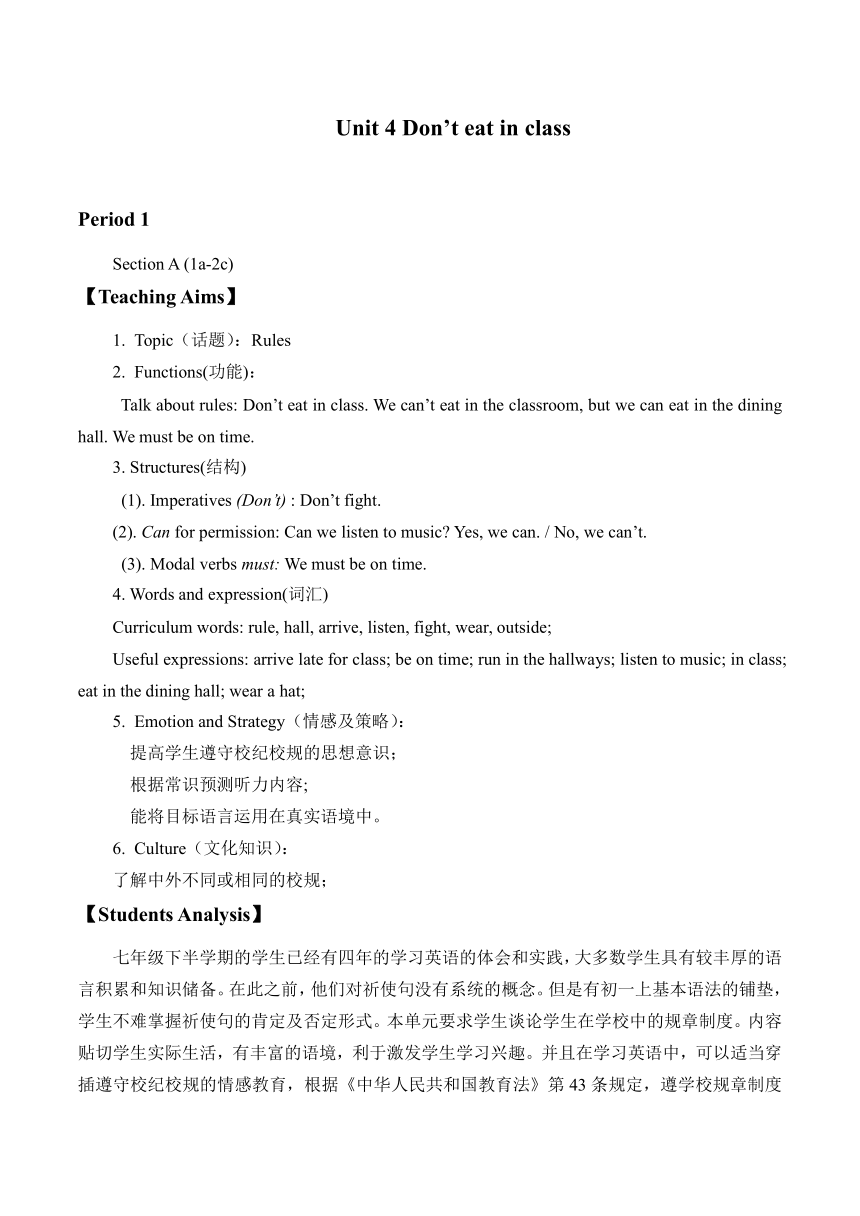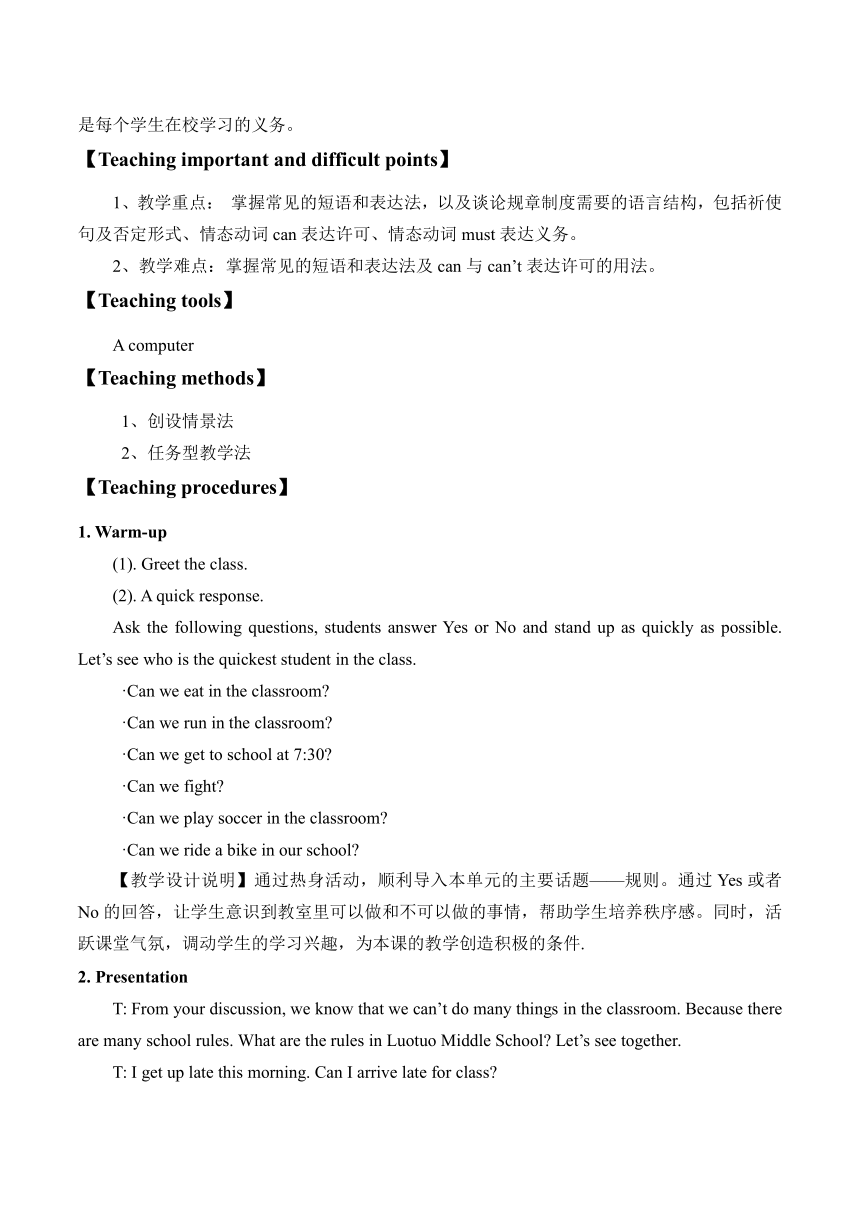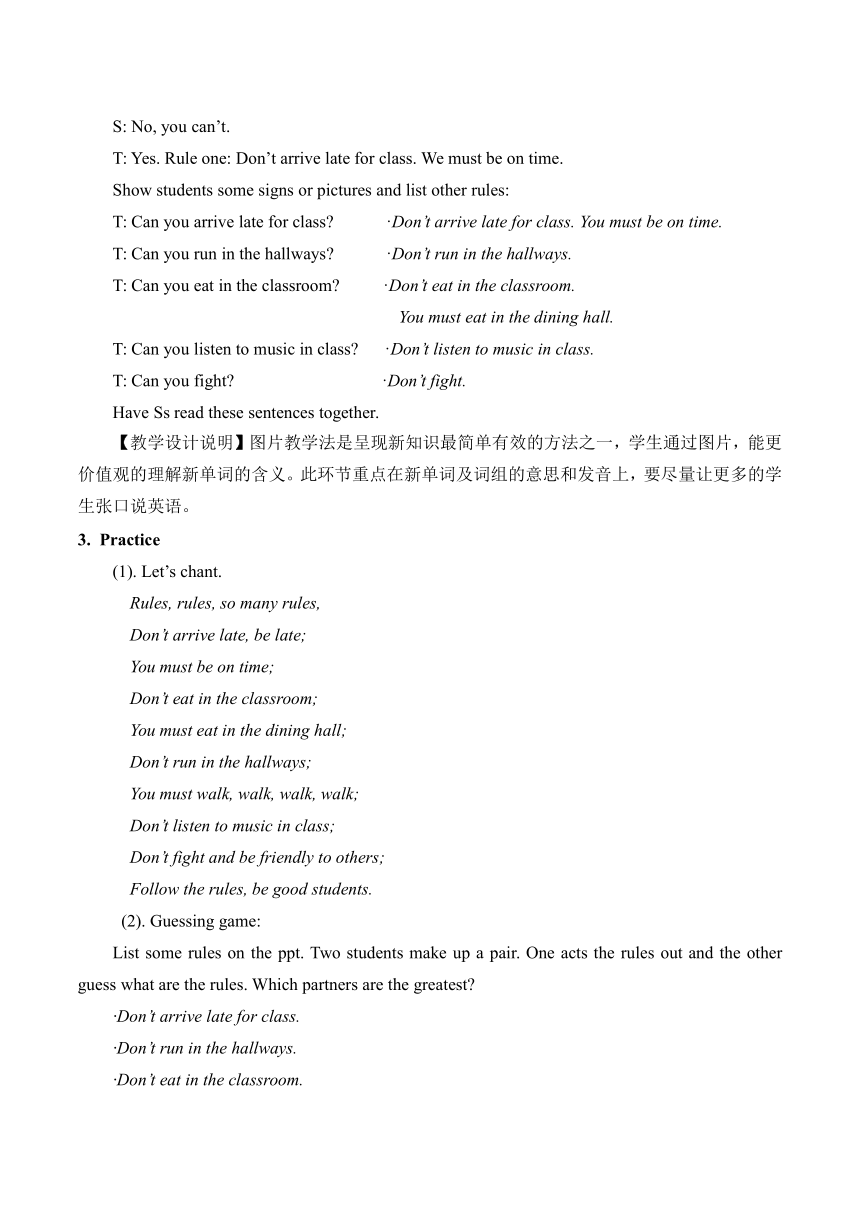Unit 4 Don't eat in class-Section A 教案
文档属性
| 名称 | Unit 4 Don't eat in class-Section A 教案 |

|
|
| 格式 | doc | ||
| 文件大小 | 39.5KB | ||
| 资源类型 | 教案 | ||
| 版本资源 | 人教新目标(Go for it)版 | ||
| 科目 | 英语 | ||
| 更新时间 | 2022-03-30 21:58:00 | ||
图片预览



文档简介
Unit 4 Don’t eat in class
Period 1
Section A (1a-2c)
【Teaching Aims】
Topic(话题):Rules
Functions(功能):
Talk about rules: Don’t eat in class. We can’t eat in the classroom, but we can eat in the dining hall. We must be on time.
3. Structures(结构)
(1). Imperatives (Don’t) : Don’t fight.
(2). Can for permission: Can we listen to music Yes, we can. / No, we can’t.
(3). Modal verbs must: We must be on time.
4. Words and expression(词汇)
Curriculum words: rule, hall, arrive, listen, fight, wear, outside;
Useful expressions: arrive late for class; be on time; run in the hallways; listen to music; in class; eat in the dining hall; wear a hat;
Emotion and Strategy(情感及策略):
提高学生遵守校纪校规的思想意识;
根据常识预测听力内容;
能将目标语言运用在真实语境中。
Culture(文化知识):
了解中外不同或相同的校规;
【Students Analysis】
七年级下半学期的学生已经有四年的学习英语的体会和实践,大多数学生具有较丰厚的语言积累和知识储备。在此之前,他们对祈使句没有系统的概念。但是有初一上基本语法的铺垫,学生不难掌握祈使句的肯定及否定形式。本单元要求学生谈论学生在学校中的规章制度。内容贴切学生实际生活,有丰富的语境,利于激发学生学习兴趣。并且在学习英语中,可以适当穿插遵守校纪校规的情感教育,根据《中华人民共和国教育法》第43条规定,遵学校规章制度是每个学生在校学习的义务。
【Teaching important and difficult points】
1、教学重点: 掌握常见的短语和表达法,以及谈论规章制度需要的语言结构,包括祈使句及否定形式、情态动词can表达许可、情态动词must表达义务。
2、教学难点:掌握常见的短语和表达法及can与can’t表达许可的用法。
【Teaching tools】
A computer
【Teaching methods】
1、创设情景法
2、任务型教学法
【Teaching procedures】
1. Warm-up
(1). Greet the class.
(2). A quick response.
Ask the following questions, students answer Yes or No and stand up as quickly as possible. Let’s see who is the quickest student in the class.
·Can we eat in the classroom
·Can we run in the classroom
·Can we get to school at 7:30
·Can we fight
·Can we play soccer in the classroom
·Can we ride a bike in our school
【教学设计说明】通过热身活动,顺利导入本单元的主要话题——规则。通过Yes或者No的回答,让学生意识到教室里可以做和不可以做的事情,帮助学生培养秩序感。同时,活跃课堂气氛,调动学生的学习兴趣,为本课的教学创造积极的条件.
2. Presentation
T: From your discussion, we know that we can’t do many things in the classroom. Because there are many school rules. What are the rules in Luotuo Middle School Let’s see together.
T: I get up late this morning. Can I arrive late for class
S: No, you can’t.
T: Yes. Rule one: Don’t arrive late for class. We must be on time.
Show students some signs or pictures and list other rules:
T: Can you arrive late for class ·Don’t arrive late for class. You must be on time.
T: Can you run in the hallways ·Don’t run in the hallways.
T: Can you eat in the classroom ·Don’t eat in the classroom.
You must eat in the dining hall.
T: Can you listen to music in class ·Don’t listen to music in class.
T: Can you fight ·Don’t fight.
Have Ss read these sentences together.
【教学设计说明】图片教学法是呈现新知识最简单有效的方法之一,学生通过图片,能更价值观的理解新单词的含义。此环节重点在新单词及词组的意思和发音上,要尽量让更多的学生张口说英语。
Practice
. Let’s chant.
Rules, rules, so many rules,
Don’t arrive late, be late;
You must be on time;
Don’t eat in the classroom;
You must eat in the dining hall;
Don’t run in the hallways;
You must walk, walk, walk, walk;
Don’t listen to music in class;
Don’t fight and be friendly to others;
Follow the rules, be good students.
(2). Guessing game:
List some rules on the ppt. Two students make up a pair. One acts the rules out and the other guess what are the rules. Which partners are the greatest
·Don’t arrive late for class.
·Don’t run in the hallways.
·Don’t eat in the classroom.
·Don’t listen to music in class.
·Don’t fight.
·Don’t play soccer in the classroom.
·Don’t play computer in the classroom.
·Don’t ride a bike in the school.
【教学设计说明】这个两个活动不但能使学生的目标语言得到操练,而且可以提高学生学习英语的兴趣,活跃课堂气氛。
4. Work on 1a
(1) T: Look at in 1a. There are five school rules. Some students in the picture break the rules. Please write the number of the rule next to the student.
(2) Talk about the picture with Ss using the target language like this:
A: Which rule is he/she breaking
B: He/ she is breaking rule 1: _____________________________.
【教学设计说明】通过1a的练习,使学生进一步学会运用新单词。和学生一起谈论图片,目的在于引导学生学会使祈使句表示规则。
5. Work on 1b
T: They are students in our Luotuo Middle School. Three students Peter, Amy and Mike are breaking the school rules. Let’s listen to the conversation and find out what rules these Ss are breaking. Write the numbers after the names.
【教学设计说明】此环节着重是听力训练。让学生在听对话的过程中抓住关键词汇,由于前面已做了一些训练,因此学生听起来比较容易,让他们都有一次成功的喜悦和感受,这样可以增强他们的学习自信心。
6. Practice ( 1c)
T: Today a new student named Tom comes to our school. He doesn’t know the school rules, please tell him the rules from 1a. Let’s work in pairs.
Move around the class while they are practicing and offer any help they need. Then ask several pairs to present their conversation to the class as following:
A: My name is Tom. I am new here. What are the rules
B: Well, we can’t________. We must____________.
A: Can we __________
B: Yes, we can./ No, we can’t.
A: Thank you.
【教学设计说明】此环节为机械操练,使不同层次学生初步掌握目标语言。机械操练是英语初始阶段教学必不可缺的部分,学生要先从模仿到初步掌握,最后才能熟练应用。由于机械操练比较简单,因此是激发后进生兴趣,培养后进生自信的一个很好的途径。
7. Work on 2a & 2b
(1). T: Two students Alan and Cindy are talking about the school rules. Look at the table in 2a. There are eight activities. Students can do some of them. Can you read and guess what they can do and what they can’t.
(2). T: Let’s listen to the tape and check the activities Alan and Cindy talk about.
Check the answer by reading them
(3). T: Let’s listen again and circle can or can’t in 2a.
(4). Check the answers by:
Can they _______________ Yes, they can./ No, they can’t.
Have students answer the questions:
·Where can they listen to music
·Where can they eat
·Can they wear a hat in class
·If two students fight, what will the teacher be like
【教学设计说明】此环节进一步巩固了本堂课所学的词汇和句型。通过反复听读,可以让学生尽快熟悉生词。帮助学生掌握情态动词can和can’t表示许可的用法。
8. Work on 2c
Student A is Alan and Student B is Cindy. Talk about the rules in 2a.
A: Can we listen to music, Cindy
B: We can’t listen to music in the hallways, but we can listen to it outside.
【教学设计说明】此环节既能充分练习学生的目标语言,使学生学以致用,同时也能极大的调动学生们的课堂参与率.
9. Discussion in group of four
Topic:What can’t we do in the classroom
After two minutes discussion, check which group can list the most rules.
【教学设计说明】此环节从学生实际情况出发,为真实语境,讨论班级中可以做及不可做的事情,从“说”的角度训练学生运用情态动词can和can’t表达许可和禁止。
10. Group work:
We often go to the school library but some students don’t know what can’t they do and let’s make rules for the school library. List what we can do or we can’t do in the classroom.
Rule 1: Don’t___________________________________
Rule 2: Don’t___________________________________
Rule 3: Don’t___________________________________
Rule 4: Don’t___________________________________
Then, make a report to the whole class. They may begin like this:
A school library must have some rules. First, we can’t________. Second, we can’t ___________. Then we can’t ____________. At last, we can’t __________, either. We make rules to help us study better. So rules are good for us and we must follow.
11.The importance of rules and law
T: In our school, we have rules. For a country, we have laws. People make rules and laws to help us live well. As a student, it is our duty to follow school rule. Look at the “The National Defense of Education of the People’s Republic of China”.
Then learn the law together and make a conclusion:
T: Rules and laws are good for us. We must follow them and to be a good student, a good person.
【教学设计说明】此环节考察学生综合语言运用能力,通过列规则,考察祈使句学习情况,通过写、读报道,考察情态动词can’t的使用情况。本活动的语境是为学校图书馆制定规则,情景真实,容易引起学生共鸣。另外,可以渗透法制教育,世界上并没有完全的自由,我们制定规则是为了更好的生活与学习,遵守规章制度是每个学生应尽的义务。
【Homework】
Level A: Finish exercise in the exercise book;
Read the words and expressions by yourselves;
Level B: Write a report on the school library rules.
【教学反思】
1.本节课的主要内容是规则。教师让学生列举教室规则,学生讲出了很多的实用的规则。让学生主动提出各种规则,便于后期班规校规的实施。
2. 教师让学生分组讨论如何制定班规,巧妙地运用了合作学习法,不但培养了学生探究问题和自主解决问题的能力,而且也培养了学生的参政议政的意识。 同学们以主人翁的身份,提出了种种解决方法。
3. 老师因势利导,请他们回忆一下,以前有否做过违反班规校规的事情。其实是英语课与政治课的整合。在这么和谐,民主、激动的气氛中,同学们毫无顾忌,畅所欲言,纷纷讲述了自己以前的不文明表现。当老师问他们以后还会做这种事吗?他们很真心地回答“ No ”。自然恰当的德育渗透,起到一箭双雕的作用,使活动达到了高潮,并且顺势讨论规则的重要性,让学生明白没有绝对的自由。
总之,整个过程,教师不是在“教教材”,而是在“用教材教”。教师根据学生的实际情况和生活经验创造性地使用教材,从学生熟悉的知识入手,创建一个个与学生生活密切相关的问题情景,让学生带着问题思考,寻找解决问题的办法。真正体现了《新课标》的精神——“在发展语言能力的同时,发展思维能力,激发想象力和创造力。”
《新课标》说;活动不应该仅限于课堂教学,而要延伸到课堂之外的学习和生活之中。同学们回忆自己的不文明行为,作自我批评,是活动的高潮,是自我教育,提高环保意识的最有效手段。当时,教师应该趁热打铁,利用同学们的这份热情,让同学们利用课余时间,用英语采访同年级的别班同学,让同学们在同龄人面前很自然地回忆自己的不文明行为。然后,以此为依据,让本班同学用英语向全校同学发一份以“保护环境”为内容的倡议书。这不但会在全校兴起一股学英语的热潮,还会使环保意识深入人心。这是实实在在的任务型教学,体现了学中用,用中学的《新课标》精神。让学生在实现任务的同时,感受成功,以形成积极的学习态度,促进英语语言实际运用能力的提高。这才真正符合《新课标》的理念。
Period 1
Section A (1a-2c)
【Teaching Aims】
Topic(话题):Rules
Functions(功能):
Talk about rules: Don’t eat in class. We can’t eat in the classroom, but we can eat in the dining hall. We must be on time.
3. Structures(结构)
(1). Imperatives (Don’t) : Don’t fight.
(2). Can for permission: Can we listen to music Yes, we can. / No, we can’t.
(3). Modal verbs must: We must be on time.
4. Words and expression(词汇)
Curriculum words: rule, hall, arrive, listen, fight, wear, outside;
Useful expressions: arrive late for class; be on time; run in the hallways; listen to music; in class; eat in the dining hall; wear a hat;
Emotion and Strategy(情感及策略):
提高学生遵守校纪校规的思想意识;
根据常识预测听力内容;
能将目标语言运用在真实语境中。
Culture(文化知识):
了解中外不同或相同的校规;
【Students Analysis】
七年级下半学期的学生已经有四年的学习英语的体会和实践,大多数学生具有较丰厚的语言积累和知识储备。在此之前,他们对祈使句没有系统的概念。但是有初一上基本语法的铺垫,学生不难掌握祈使句的肯定及否定形式。本单元要求学生谈论学生在学校中的规章制度。内容贴切学生实际生活,有丰富的语境,利于激发学生学习兴趣。并且在学习英语中,可以适当穿插遵守校纪校规的情感教育,根据《中华人民共和国教育法》第43条规定,遵学校规章制度是每个学生在校学习的义务。
【Teaching important and difficult points】
1、教学重点: 掌握常见的短语和表达法,以及谈论规章制度需要的语言结构,包括祈使句及否定形式、情态动词can表达许可、情态动词must表达义务。
2、教学难点:掌握常见的短语和表达法及can与can’t表达许可的用法。
【Teaching tools】
A computer
【Teaching methods】
1、创设情景法
2、任务型教学法
【Teaching procedures】
1. Warm-up
(1). Greet the class.
(2). A quick response.
Ask the following questions, students answer Yes or No and stand up as quickly as possible. Let’s see who is the quickest student in the class.
·Can we eat in the classroom
·Can we run in the classroom
·Can we get to school at 7:30
·Can we fight
·Can we play soccer in the classroom
·Can we ride a bike in our school
【教学设计说明】通过热身活动,顺利导入本单元的主要话题——规则。通过Yes或者No的回答,让学生意识到教室里可以做和不可以做的事情,帮助学生培养秩序感。同时,活跃课堂气氛,调动学生的学习兴趣,为本课的教学创造积极的条件.
2. Presentation
T: From your discussion, we know that we can’t do many things in the classroom. Because there are many school rules. What are the rules in Luotuo Middle School Let’s see together.
T: I get up late this morning. Can I arrive late for class
S: No, you can’t.
T: Yes. Rule one: Don’t arrive late for class. We must be on time.
Show students some signs or pictures and list other rules:
T: Can you arrive late for class ·Don’t arrive late for class. You must be on time.
T: Can you run in the hallways ·Don’t run in the hallways.
T: Can you eat in the classroom ·Don’t eat in the classroom.
You must eat in the dining hall.
T: Can you listen to music in class ·Don’t listen to music in class.
T: Can you fight ·Don’t fight.
Have Ss read these sentences together.
【教学设计说明】图片教学法是呈现新知识最简单有效的方法之一,学生通过图片,能更价值观的理解新单词的含义。此环节重点在新单词及词组的意思和发音上,要尽量让更多的学生张口说英语。
Practice
. Let’s chant.
Rules, rules, so many rules,
Don’t arrive late, be late;
You must be on time;
Don’t eat in the classroom;
You must eat in the dining hall;
Don’t run in the hallways;
You must walk, walk, walk, walk;
Don’t listen to music in class;
Don’t fight and be friendly to others;
Follow the rules, be good students.
(2). Guessing game:
List some rules on the ppt. Two students make up a pair. One acts the rules out and the other guess what are the rules. Which partners are the greatest
·Don’t arrive late for class.
·Don’t run in the hallways.
·Don’t eat in the classroom.
·Don’t listen to music in class.
·Don’t fight.
·Don’t play soccer in the classroom.
·Don’t play computer in the classroom.
·Don’t ride a bike in the school.
【教学设计说明】这个两个活动不但能使学生的目标语言得到操练,而且可以提高学生学习英语的兴趣,活跃课堂气氛。
4. Work on 1a
(1) T: Look at in 1a. There are five school rules. Some students in the picture break the rules. Please write the number of the rule next to the student.
(2) Talk about the picture with Ss using the target language like this:
A: Which rule is he/she breaking
B: He/ she is breaking rule 1: _____________________________.
【教学设计说明】通过1a的练习,使学生进一步学会运用新单词。和学生一起谈论图片,目的在于引导学生学会使祈使句表示规则。
5. Work on 1b
T: They are students in our Luotuo Middle School. Three students Peter, Amy and Mike are breaking the school rules. Let’s listen to the conversation and find out what rules these Ss are breaking. Write the numbers after the names.
【教学设计说明】此环节着重是听力训练。让学生在听对话的过程中抓住关键词汇,由于前面已做了一些训练,因此学生听起来比较容易,让他们都有一次成功的喜悦和感受,这样可以增强他们的学习自信心。
6. Practice ( 1c)
T: Today a new student named Tom comes to our school. He doesn’t know the school rules, please tell him the rules from 1a. Let’s work in pairs.
Move around the class while they are practicing and offer any help they need. Then ask several pairs to present their conversation to the class as following:
A: My name is Tom. I am new here. What are the rules
B: Well, we can’t________. We must____________.
A: Can we __________
B: Yes, we can./ No, we can’t.
A: Thank you.
【教学设计说明】此环节为机械操练,使不同层次学生初步掌握目标语言。机械操练是英语初始阶段教学必不可缺的部分,学生要先从模仿到初步掌握,最后才能熟练应用。由于机械操练比较简单,因此是激发后进生兴趣,培养后进生自信的一个很好的途径。
7. Work on 2a & 2b
(1). T: Two students Alan and Cindy are talking about the school rules. Look at the table in 2a. There are eight activities. Students can do some of them. Can you read and guess what they can do and what they can’t.
(2). T: Let’s listen to the tape and check the activities Alan and Cindy talk about.
Check the answer by reading them
(3). T: Let’s listen again and circle can or can’t in 2a.
(4). Check the answers by:
Can they _______________ Yes, they can./ No, they can’t.
Have students answer the questions:
·Where can they listen to music
·Where can they eat
·Can they wear a hat in class
·If two students fight, what will the teacher be like
【教学设计说明】此环节进一步巩固了本堂课所学的词汇和句型。通过反复听读,可以让学生尽快熟悉生词。帮助学生掌握情态动词can和can’t表示许可的用法。
8. Work on 2c
Student A is Alan and Student B is Cindy. Talk about the rules in 2a.
A: Can we listen to music, Cindy
B: We can’t listen to music in the hallways, but we can listen to it outside.
【教学设计说明】此环节既能充分练习学生的目标语言,使学生学以致用,同时也能极大的调动学生们的课堂参与率.
9. Discussion in group of four
Topic:What can’t we do in the classroom
After two minutes discussion, check which group can list the most rules.
【教学设计说明】此环节从学生实际情况出发,为真实语境,讨论班级中可以做及不可做的事情,从“说”的角度训练学生运用情态动词can和can’t表达许可和禁止。
10. Group work:
We often go to the school library but some students don’t know what can’t they do and let’s make rules for the school library. List what we can do or we can’t do in the classroom.
Rule 1: Don’t___________________________________
Rule 2: Don’t___________________________________
Rule 3: Don’t___________________________________
Rule 4: Don’t___________________________________
Then, make a report to the whole class. They may begin like this:
A school library must have some rules. First, we can’t________. Second, we can’t ___________. Then we can’t ____________. At last, we can’t __________, either. We make rules to help us study better. So rules are good for us and we must follow.
11.The importance of rules and law
T: In our school, we have rules. For a country, we have laws. People make rules and laws to help us live well. As a student, it is our duty to follow school rule. Look at the “The National Defense of Education of the People’s Republic of China”.
Then learn the law together and make a conclusion:
T: Rules and laws are good for us. We must follow them and to be a good student, a good person.
【教学设计说明】此环节考察学生综合语言运用能力,通过列规则,考察祈使句学习情况,通过写、读报道,考察情态动词can’t的使用情况。本活动的语境是为学校图书馆制定规则,情景真实,容易引起学生共鸣。另外,可以渗透法制教育,世界上并没有完全的自由,我们制定规则是为了更好的生活与学习,遵守规章制度是每个学生应尽的义务。
【Homework】
Level A: Finish exercise in the exercise book;
Read the words and expressions by yourselves;
Level B: Write a report on the school library rules.
【教学反思】
1.本节课的主要内容是规则。教师让学生列举教室规则,学生讲出了很多的实用的规则。让学生主动提出各种规则,便于后期班规校规的实施。
2. 教师让学生分组讨论如何制定班规,巧妙地运用了合作学习法,不但培养了学生探究问题和自主解决问题的能力,而且也培养了学生的参政议政的意识。 同学们以主人翁的身份,提出了种种解决方法。
3. 老师因势利导,请他们回忆一下,以前有否做过违反班规校规的事情。其实是英语课与政治课的整合。在这么和谐,民主、激动的气氛中,同学们毫无顾忌,畅所欲言,纷纷讲述了自己以前的不文明表现。当老师问他们以后还会做这种事吗?他们很真心地回答“ No ”。自然恰当的德育渗透,起到一箭双雕的作用,使活动达到了高潮,并且顺势讨论规则的重要性,让学生明白没有绝对的自由。
总之,整个过程,教师不是在“教教材”,而是在“用教材教”。教师根据学生的实际情况和生活经验创造性地使用教材,从学生熟悉的知识入手,创建一个个与学生生活密切相关的问题情景,让学生带着问题思考,寻找解决问题的办法。真正体现了《新课标》的精神——“在发展语言能力的同时,发展思维能力,激发想象力和创造力。”
《新课标》说;活动不应该仅限于课堂教学,而要延伸到课堂之外的学习和生活之中。同学们回忆自己的不文明行为,作自我批评,是活动的高潮,是自我教育,提高环保意识的最有效手段。当时,教师应该趁热打铁,利用同学们的这份热情,让同学们利用课余时间,用英语采访同年级的别班同学,让同学们在同龄人面前很自然地回忆自己的不文明行为。然后,以此为依据,让本班同学用英语向全校同学发一份以“保护环境”为内容的倡议书。这不但会在全校兴起一股学英语的热潮,还会使环保意识深入人心。这是实实在在的任务型教学,体现了学中用,用中学的《新课标》精神。让学生在实现任务的同时,感受成功,以形成积极的学习态度,促进英语语言实际运用能力的提高。这才真正符合《新课标》的理念。
同课章节目录
- Unit 1 Can you play the guitar?
- Section A
- Section B
- Unit 2 What time do you go to school?
- Section A
- Section B
- Unit 3 How do you get to school?
- Section A
- Section B
- Unit 4 Don't eat in class.
- Section A
- Section B
- Unit 5 Why do you like pandas?
- Section A
- Section B
- Unit 6 I'm watching TV.
- Section A
- Section B
- Review of Units 1-6
- Unit 7 It's raining!
- Section A
- Section B
- Unit 8 Is there a post office near here?
- Section A
- Section B
- Unit 9 What does he look like?
- Section A
- Section B
- Unit 10 I'd like some noodles.
- Section A
- Section B
- Unit 11 How was your school trip?
- Section A
- Section B
- Unit 12 What did you do last weekend?
- Section A
- Section B
